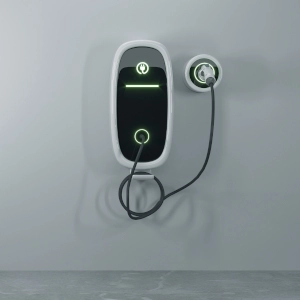Sponsrat innehåll från Broadband Tecchnology AB – A CODICO Company

Leakage current sensors for charging stations
Every household has one
Most people are familiar with the residual current device (RCD) from their fuse box in the basement. Though one will find several old buildings still equipped with safety fuses and cabling without earth wire, they are becoming increasingly rare. This is fortunate, since the task of the safety fuse or the circuit breaker is limited to protecting the powerlines from overcurrent, i.e. it constitutes a fire protection measure. The RCD, on the other hand, directly protects humans against fatal electric shocks. It compares whether the amount of current flowing out of the circuit is equal to the amount that flowed in. Any deviation points out to the presence of a leakage current which...
may be flowing, e.g. into a person. The residual current device usually switches off at 30mA leakage current, and the alternating mains current becomes potentially lethal for humans above 50mA. Statistics demonstrate how important a modern electrical installation is for the protection of occupants. While the VDE registered over 250 lethal electrical accidents in Germany in 1970, this number had dropped to just 43 by 2018. Incidentally, 34 out of the 43 fatalities were men, who like to tinker with electrical installations, but obviously lack the necessary caution and care – who needs a voltage tester, when the tip of a finger will also do?
Safety when charging an electric car
A major shift in transportation is already on its way, and the race seems to be decided: passenger cars with combustion engines will be replaced by PEVs (plug-in electric vehicles). The market for charging stations and wall boxes (electric vehicle supply equipment) is developing accordingly, and in some cities public charging columns are springing up like mushrooms. As electric vehicles increasingly become a mass phenomenon, the sales figures for wall boxes are also set to explode, since garage owners will of course want to comfortably charge their cars overnight or at the company car park, so they can start with a "full tank" each morning or after work. As a result, public charging columns are only relevant for long-distance travelling, and the traditional excursion to the filling station for petrol and diesel car owners will become a thing of the past.
One should not allow safety to take a back seat, however, since, during charging, enormous currents in the two-digit ampere range flow into the batteries and, in future, from the batteries (vehicle-to-grid) back to the grid. Isolation errors can also cause leakage currents in the cables or the car, and humans and animals need to be protected against these.
This problem was addressed in Europe and some other parts of the world with the standard IEC 62752:2016 (In-cable control and protection device for mode 2 charging of electric road vehicles (IC-CPD)). The standard for mode 2 charging with a charging cable does not only require detection and switch-off in case of AC leakage currents > 30mA, but also for DC leakage currents > 6mA.
As a result of the integrated leakage current protection in the charging station or the cable, the home installation only requires an inexpensive type A RCD.
Integrated and future-safe solution in compliance with the standards
The FG-R05-3A is the first sensor of a series put on the market by KEMET, which is IEC 62752-compliant and offers an integrated solution in a very small space. Further models with the same functionality and in different form factors will be introduced into the market until the end of 2020 to meet the requirements of different mechanical installation situations in AC wall boxes and charging cables.
As of January 2022, an additional standard will govern mode 3 charging with AC wall boxes (IEC 62955:2018 Residual direct current detecting device (RDC-DD) to be used for mode 3 charging of electric vehicles). The changes affect the triggering thresholds, since the maximum possible charging current according to the standard will rise to above 100A. With regard to DC leakage current, the threshold remains at 6mA, but it increases to 60mA for AC.
The corresponding sensors in compliance with the standard are already under development at KEMET and will be available in time. These will be designed for a maximum current of 40A for three-phase systems and 80A for single-phase systems, reaching a charging power of approx. 22kW. The sensors will be fully compatible with their mode 2 versions, both mechanically and electrically. Therefore, you can already begin designing with the currently available sensors in mind, so that, when the new standard enters into force, you can switch to the new sensors in time with a simple BOM change, without having to modify the layout.
Structure and function
The sensor consists of a coupling coil and an ASIC that integrates the evaluation electronics. It is welded on the PCB as a THT component, and the charging cable passes through a hole in the sensor. Where the inductively detected total current is not zero, leakage current is present, pointing out to an isolation error in the charging cable or the car. The leakage current in the coil detunes an oscillator, and the electronics will measure the respective high and low times of the resulting output signal. One can thus determine not only the absolute value of the leakage current but also its direction, which is a very valuable piece of information for error diagnosis.
The electronic system is fed with 5V and reports to 5V logic outputs when the AC or DC leakage current threshold is exceeded, so that the corresponding contactors can be dropped to disconnect the charging cable. In addition, an analogue output was integrated, which linearly reads the DC leakage current and - superimposed with 50Hz - the AC leakage current, thus allowing the charging controller to monitor the leakage currents. As a result, it is possible to react already before the threshold stipulated in the standards is exceeded, e.g. to trigger maintenance in time before the charging column will have to be put out of service. This is an added value one should not underestimate.
Conclusion
RCDs by KEMET not only allow you to meet the requirements of global standards for the safety of e-mobility charging stations, they also provide you with a compact, integrated, and future-safe solution and, thanks to their intelligent evaluation electronics, with valuable additional information.
Besök gärna Broadband
Magnus Gustavsson CEO/Broadband AB
+46 705 679 707
Andreas Dirschl FAE CODICO GmbH
+49 891 301 438 20

